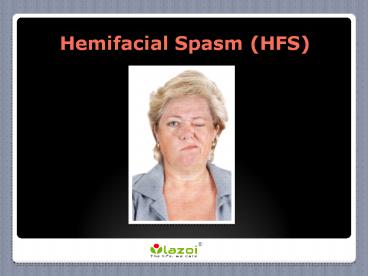Hemifacial Spasm: Overview of symptoms, causes and treatment - PowerPoint PPT Presentation
Title:
Hemifacial Spasm: Overview of symptoms, causes and treatment
Description:
Hemifacial Spasm (HFS) is a neuromuscular disorder, generally observed in middle-aged men and women, and it inflicts the muscles of one side of the face. – PowerPoint PPT presentation
Number of Views:174
Title: Hemifacial Spasm: Overview of symptoms, causes and treatment
1
Hemifacial Spasm (HFS)
2
Hemifacial Spasm (HFS)
- Hemifacial Spasm (HFS) is a neuromuscular
disorder, generally observed in middle-aged men
and women, and it inflicts the muscles of one
side of the face. These muscles undergo frequent,
involuntary twitching or contractions. In this
disorder, the seventh cranial nerve is
constricted by blood vessels, which results in
the varying degrees of facial spasms. The
treatment encompasses the use of oral medicines,
injections, and surgery.
3
Causes of Hemifacial Spasm (HFS)
- A common cause is injury to the facial nerves,
which serve as the carriers of signals from the
brain to the facial muscles. Any damage to these
nerves may hinder the communication of
information, resulting in twitching or
compression. Such damage may also occur due to
the development of a tumour. In some cases, a
dislocated blood vessel may exert pressure on the
facial nerve, thereby disrupting the normal
neural communication. In the brain-stem, the
facial nerve originates at a point which is known
as the anterior inferior cerebellar artery.
4
Causes of Hemifacial Spasm (HFS)
Continue
- This artery may cause a build-up of pressure on
the facial nerve, causing it to misfire,
eventually resulting in the abnormal contraction
of the facial muscles. - Another probable cause of hemifacial spasm is a
condition known as Bell's palsy. Here, the nerve
which is responsible for keeping a control on the
facial muscles gets inflamed.
5
Symptoms
- In the early stages, the affected person may
experience such contractions around the eye. Over
time, the condition tends to spread to the lower
facial muscles, and the mouth seems to be pulled
to one side. This happens in most of the
cases. In some patients, the symptoms start
near the chin, and progress in an upward
direction. Generally, the twitching is not
painful. However, the unsightly facial expression
may become a source of embarrassment in public.
6
Treatments
- Oral medication, injections, and surgery are the
three major treatment options for this condition.
Patients are kept under routine monitoring, and
have to undergo blood tests.Oral medication
comprises anti-convulsant drugs
like carbamazepine or phenytoin. These drugs help
to suppress the rapid and excessive firing of
neurons, and control the twitching. As the facial
muscles undergo extreme amount of pressure and
discomfort due to the frequent episodes of
twitching or contraction, muscle relaxants may be
recommended. The common examples
include baclofen, diazepam, and clonazepam.
7
Treatments
Continue
- Injections for the treatment of hemifacial spasm
include botox injections, which cause
temporary muscle paralysis. A neurotransmitter
known as acetylcholine carries the electrical
messages transmitted to the muscles. Botox
injections block such messages, and help in
reducing or preventing the contraction of
muscles. The effect of such injections begins in
three days, and may persist for a period of about
three months. Side effects like facial
weakness, eye irritation, and droopy eyelids may
be experienced.
8
Treatments
Continue
- Cases which show no improvement despite the use
of medications and botox injections are dealt
with the help of a surgery known as microvascular
decompression. About 90 of patients have been
observed to be completely cured, after about two
months. Try to avoid stress, emotional strain,
fatigue, bright lights, excessive reading, etc.,
because factors like these are known to aggravate
the symptoms of this condition.
9
CONNECT WITH US
- Logon to
- www.lazoi.com
- Like us on Facebook
- https//www.facebook.com/LazoiTheLife
- Follow us on Twitter
- https//www.twitter.com/lazoithelife
- Follow us on Pinterest
- https//www.in.pinterest.com/lazoithelife































